Driven by our insatiable demand for food and drink; some because of basic necessity and others as a luxury, we humans have a tendency to put profit before sustainability. Nowhere is this better typified than with basic consumables, such as cocoa, tea, coffee and oil.
These industries represent huge commodity markets. For instance, the global coffee market alone is worth close to $18 billion in 2020, making it the second most valuably traded commodity after oil. Unfortunately, where there’s money to be made, there are corners to be cut in the name of profit.
But this is a coffee site, so let’s focus on how we can make the planet a better place by being especially careful in what products we actively encourage through our drinking habits.
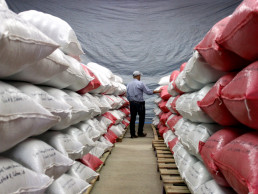
The more we make well considered and well informed choices about the products we consume, the less places unsustainable production practices will have to hide. At the end of the day, of course, it comes down to the basic buying public – the consumer, and importantly three things:
- The willingness to read the contents and original of a product on the packaging
- The motivation to make a difference by changing buying habits.
- The availability of the information on packaging to make an informed decision.
Not surprisingly, not all coffee producers and distributors want to have this information displayed, especially budget brands that may contain variety of differently sourced coffee. Even some quality brands go to great lengths to ‘greenwash’ their products. This is where a product makes a big noise about believing in being eco friendly and perhaps spending more time talking than doing. Unfortunately, where some well-know brands are concerned, it works and consumers are lulled into a false sense of making what they think are ecologically sensible choices.
Look for what’s not there
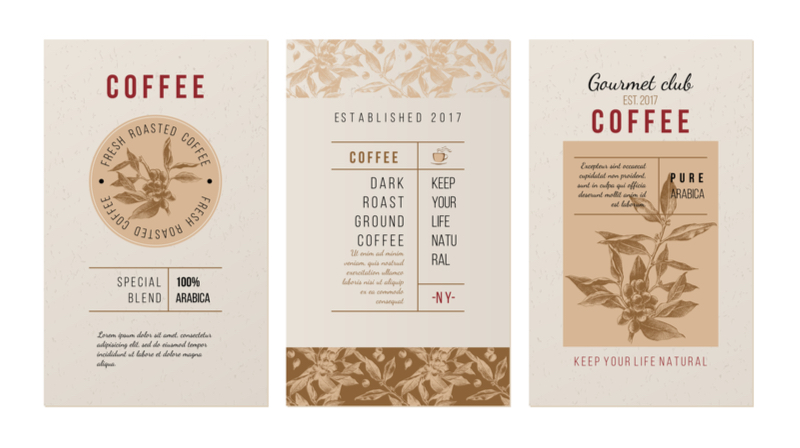 This sounds like Chinese wisdom, but the first step is to understand what exactly you’re buying by looking for what isn’t said on the packet. As is in life, what’s not said is the most important piece of information.
This sounds like Chinese wisdom, but the first step is to understand what exactly you’re buying by looking for what isn’t said on the packet. As is in life, what’s not said is the most important piece of information.
Producers distributing ‘Eco sensitive’ coffee that is genuinely produced in sustainable, Eco friendly ways, will want to go to some lengths to tell you this. One reason is that the product is likely more expensive than your typical run of the mill instant coffee; not because they want to price gouge you, but because the cultivation methods are more natural, require more care and the local people involved get to earn a fair wage for their hard work. For you to want to spend more, you have to have a great reason, and this is probably it – saving the planet one bean at a time.
One key area, we as coffee consumers, should be aware of, is the difference between ‘sun and shade’ grown coffee.
Sun grown coffee
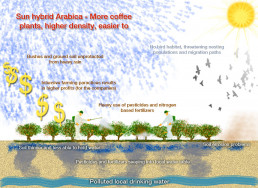
As its name suggests, sun grown coffee is produced on coffee plantations that expose the coffee plants to direct sunlight.
There are both problems and benefits to this, but the overall method of production is quite negative on the environment.
The benefits – to the growers at least
- Coffee plants don’t naturally grow in direct sunlight and when they are, they grow very fast, meaning the grower can get two crops a year.
- Plantations are neatly laid out in readily harvestable rows, like many agricultural crops, facilitating highly efficient mechanised harvesting.
The downside
- Directly exposing the soil to sun and wind quickly degrades the soil causing erosion.
- A poorer quality soil means that farmers have to turn to fertilisers. But these don’t last forever and eventually, the soil becomes unsuitable for coffee production.
- A focus on high yield crops invariably means the use of pesticides to control insects and other pests. Also, as there are no other plants growing, there is very little habitat. This deters other animals including birds and so sun based coffee plantations have little bio diversity.
- As there are no other plants and trees to help with the water cycle, a great deal of water drains out of the coffee plantation or into the local water table, taking chemical fertilisers and pesticides with it.
Shade grown coffee

As the name suggests, coffee grown in this manner is typically grown in the shade of other plants, most typically trees. Many shade coffee plantations within rain forests. The benefits of this production method are:
- Coffee growth is normal as this is the environment it grows naturally in. The coffee plants don’t require fertiliser or pesticides as the forest environment has a natural eco system that provided nutrients and natural pesticides in the form of the insect food chain. Bio diversity, means there’s a balance in the forest.
- There’s no soil erosion and the water cycle remains unpolluted.
- There’s a certain stability shade grown coffee brings to the natural cycle. Bird friendly production such as this means that habitats remain intact, biodiversity in maintained and migrating wildlife has a place to return to each year.
- Plantations can be much smaller and managed by individual owners, providing more opportunities for entrepreneurial growers and much needed income for their families.
The main downside to shade grown coffee is simply that production costs are higher. Harvesting has to be done largely by hand as machines are difficult to use within the confines of a rain forest. Naturally, this results in a higher price in the shops.
Spotting sustainable coffee in the supermarket
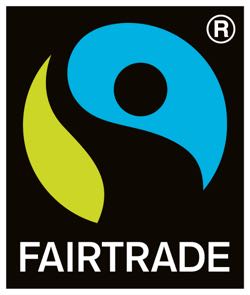
Fairtrade Certified
By now, many people are familiar with this logo appearing on product packaging. Not just coffee, many consumables have got involved with this. Coffee producers that are Fair-trade Certified are ensured a fair deal for their work, help protect them and build a sustainable future. It also requires them to adhere to strict social standards that promote healthy working conditions and prevent child labor. Certification helps producers protect their local environments and ecosystems through standards. More on Fairtrade can be found here.

Organic Certification through International Federation of Organic Agriculture Movements (IFOAM)
IFOAM set out a range of basic standards for organic agriculture, not just coffee. Their standards cover not only the use of synthetic pesticides but also a wide range of issues from nature conservancy to the use of genetically modified products.
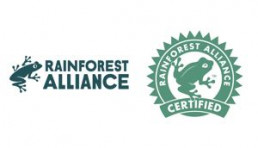
Rainforest Alliance
Coffee production threatens rain forest ecosystems and the Rainforest Alliance aims to help growers understand the benefits of forested production particularly in preserving wild life habitats. The Alliance also fights for sustainable living and working conditions for the growers.

SMC “Bird Friendly”
This is a Smithsonian Migratory Bird Center’s shade-grown coffee certification program. It promotes the growth of coffee that is economically, environmentally and socio-culturally viable. The program focuses on the benefits of shade grown coffee in maintaining a healthy ecosystem for birds, plant, mammals and reptiles.
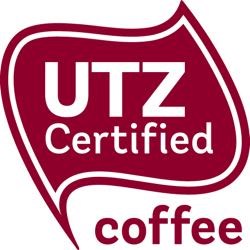
UTZ Certified
UTZ CERTIFIED sets out a Code of Conduct that establishes a set of social and environmental criteria for responsible coffee growing practices and efficient farm management. Annual inspections check on the use of chemicals, worker healthcare, rights, and access to education.
